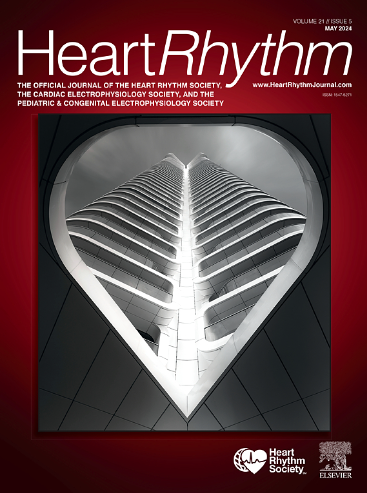Accelerated biological aging and risk of atrial fibrillation: A cohort study
IF 5.7
2区 医学
Q1 CARDIAC & CARDIOVASCULAR SYSTEMS
引用次数: 0
Abstract
Background
Even though aging has been demonstrated to be associated with a higher risk of atrial fibrillation (AF), it is unclear whether biological aging is associated with risk of incident AF.
Objective
This study aimed to investigate the association between biological aging and AF.
Methods
A total of 371,882 participants without AF at baseline from the UK Biobank were included. The incident AF was ascertained through linkage to the UK National Health Services register. Biological age was evaluated from clinical traits by the Klemera-Doubal method–biological age (KDM-BA) and PhenoAge algorithms. The residual discrepancies between biological age and chronological age were defined as the age accelerations (KDM-BA acceleration and PhenoAge acceleration). The Cox proportional hazards model was used to evaluate the effects of age accelerations with the risk of incident AF.
Results
During a mean follow-up of 13.04 years, a total of 28,076 new cases of AF were identified. Accelerated biological age was associated with an increased risk of AF, with a hazard ratio of 1.11 (95% confidence interval, 1.10–1.13) per standard deviation increase in KDM-BA acceleration (10.9 years) and 1.28 (95% confidence interval, 1.27–1.30) in PhenoAge acceleration (5.6 years).
Conclusion
Accelerated biological age quantified by clinical biomarkers is associated with increased risks of AF. Biological aging may represent a potential risk factor for incident AF in midlife and older adults and a potential target for risk assessment and intervention.
生物老化加速与心房颤动风险:一项队列研究
背景:尽管衰老已被证实与心房颤动(房颤)的高风险有关,但目前还不清楚生物衰老是否与心房颤动的发病风险有关。目前尚不清楚生物老化是否与房颤发病风险有关:本研究旨在调查生物老化与房颤之间的关系:方法:共纳入英国生物库中 371,882 名基线时无房颤的参与者。通过与英国国民健康服务登记册的关联确定了心房颤动的发病情况。根据临床特征,分别使用克莱默拉-杜巴生物年龄法(KDM-BA)和PhenoAge算法评估生物年龄。生物年龄与年代年龄之间的残差被定义为年龄加速度(KDM-BA 加速度和 PhenoAge 加速度)。采用 Cox 比例危险模型评估年龄加速度对房颤发病风险的影响:结果:在平均 13.04 年的随访期间,共发现 28,076 例新发房颤病例。KDM-BA加速度(10.9岁)每增加一个标准差(SD)的危险比(HR)为1.11(95%置信区间[CIs] 1.10 - 1.13),PhenoAge加速度(5.6岁)每增加一个标准差(SD)的危险比(HR)为1.28(95%CI 1.27 - 1.30):结论:临床生物标志物量化的生物年龄加速与房颤风险增加有关。生物衰老可能是中老年人发生房颤的潜在风险因素,也是风险评估和干预的潜在目标。
本文章由计算机程序翻译,如有差异,请以英文原文为准。
求助全文
约1分钟内获得全文
求助全文
来源期刊

Heart rhythm
医学-心血管系统
CiteScore
10.50
自引率
5.50%
发文量
1465
审稿时长
24 days
期刊介绍:
HeartRhythm, the official Journal of the Heart Rhythm Society and the Cardiac Electrophysiology Society, is a unique journal for fundamental discovery and clinical applicability.
HeartRhythm integrates the entire cardiac electrophysiology (EP) community from basic and clinical academic researchers, private practitioners, engineers, allied professionals, industry, and trainees, all of whom are vital and interdependent members of our EP community.
The Heart Rhythm Society is the international leader in science, education, and advocacy for cardiac arrhythmia professionals and patients, and the primary information resource on heart rhythm disorders. Its mission is to improve the care of patients by promoting research, education, and optimal health care policies and standards.
 求助内容:
求助内容: 应助结果提醒方式:
应助结果提醒方式:


